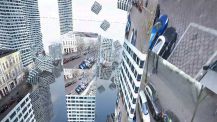360° Mobile VR App
The 360° media art mobile VR app Nonplace – the Age of the Novacene investigates the relationship between humans and nature in the Novocene[1] era. Nonplace – the Age of the Novacene deals with the loss of identities through technological progress and globalisation and poses the question of what it means when cities, shopping centres, everyday objects, etc. become more and more similar. In Nonplace – the Age of the Novacene, you fly through an endless futuristic city. You cover the skyscrapers with images that are taken automatically by the app. The skyscrapers all look the same and form a single city, a single endless city in which there are no differences. You fly through the city and cover the skyscrapers fully automatically with your individual images, which you continuously take of your surroundings with the mobile camera. In this way, you give the city continuously a new identity, which then collapses again.
Nonplace – Age of the Novocene transforms visually and conceptually into virtual space what Marc Augé describes in his book and essay ‘Non-places’. According to Augé: “Super modernity produces non-places, meaning spaces which are not themselves anthropological spaces and which do not integrate to earlier places (…) A world where people are born in the clinic and die in hospital, where transit points and temporary abodes are proliferating under luxurious or inhuman conditions (hotel chains and squats, holiday clubs and refugee camps, (…); where a dense network of means of transport which are also inhabited spaces is developing; where the habitué of communicates wordlessly, through gestures, with an abstract, unmediated commerce (i.e. credit card transactions); a world thus surrounded by solitary individuality”.[2]
References



